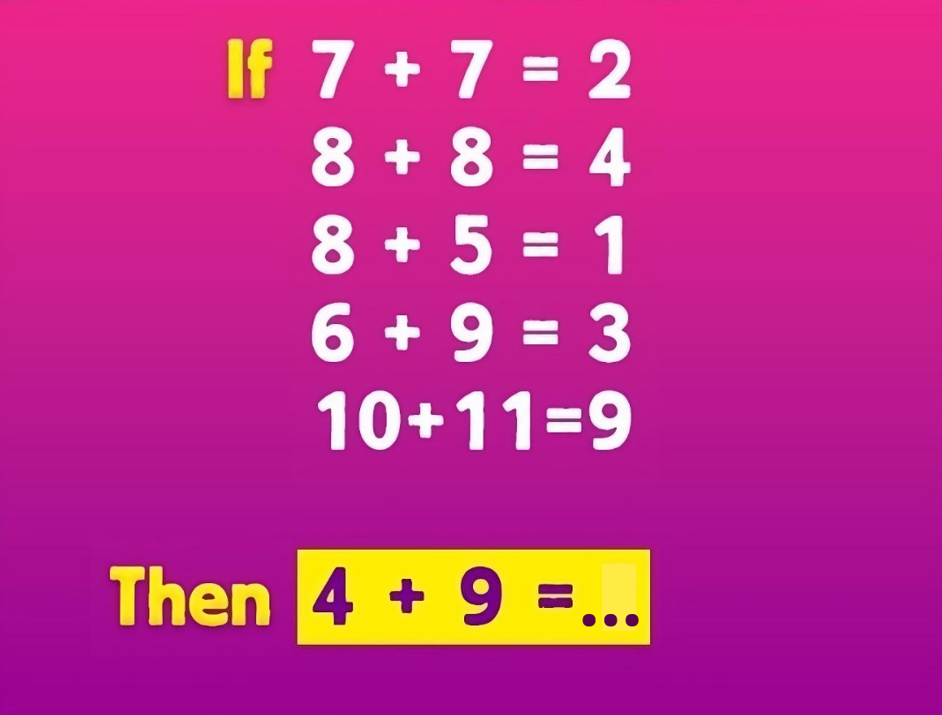Puzzles like this one aren’t just a fun way to pass the time—they’re also excellent tools for sharpening your analytical and logical thinking skills. At first glance, this puzzle may seem like a simple math problem. But as you dive in, you’ll quickly realize it’s far from ordinary arithmetic. Ready to give it a shot? Take a moment to solve it before scrolling further.
Why Puzzles Like These Challenge Conventional Thinking

When faced with a problem like this, most people instinctively turn to traditional math rules. After all, basic math says 7 + 7 equals 14, right? Not here. That’s the trick with these types of puzzles—they force you to break out of standard thinking patterns and look for hidden rules or patterns.
Here are some common pitfalls people encounter:
- Assuming standard arithmetic rules apply. Traditional math often doesn’t hold in puzzles like these. The challenge lies in finding the underlying logic.
- Overlooking subtle details. Hidden patterns often hinge on small, easily missed clues within the problem.
- Jumping to conclusions. It’s tempting to make guesses, but solving puzzles like these requires patience and careful reasoning.
- Failing to test hypotheses. Even if you think you’ve cracked the code, you need to ensure your solution applies to all parts of the puzzle.
Let’s unravel this puzzle step by step and uncover the mystery behind the strange equations.
Breaking It Down: Understanding the Puzzle
Here are the equations we’re working with:
- 7 + 7 = 2
- 8 + 8 = 4
- 8 + 5 = 1
- 6 + 9 = 3
- 10 + 11 = 9
Clearly, these equations don’t follow conventional math. Our task is to identify the hidden rule that explains these puzzling results.
Step 1: Analyze the Inputs and Outputs
The first step is to analyze how the inputs (the two numbers being added) relate to the outputs (the answers). At a glance, it’s clear that the results don’t align with basic addition.
Take note of patterns or possible operations that could transform the inputs into the outputs. Sometimes, it’s not about addition but rather a combination of operations like subtraction, division, or something even more abstract.
Step 2: Identify a Pattern
One hypothesis is to consider the relationship between the sum of the two numbers and the result. Could the output be derived by subtracting a consistent number? Let’s test this theory.
- For 7 + 7 = 2:
The sum of 7 + 7 is 14. Subtracting 12 gives 2. - For 8 + 8 = 4:
The sum of 8 + 8 is 16. Subtracting 12 gives 4. - For 8 + 5 = 1:
The sum of 8 + 5 is 13. Subtracting 12 gives 1. - For 6 + 9 = 3:
The sum of 6 + 9 is 15. Subtracting 12 gives 3. - For 10 + 11 = 9:
The sum of 10 + 11 is 21. Subtracting 12 gives 9.
The pattern holds! The rule is simple: add the two numbers, then subtract 12.
Step 3: Apply the Rule to Solve the Final Equation
Now that we’ve identified the rule, let’s apply it to a new equation: 4 + 9 = ?.
- Add 4 and 9 to get 13.
- Subtract 12 from 13, which leaves us with 1.
So, the answer is 1.
Why This Puzzle Is a Great Brain Exercise
This puzzle challenges your ability to think outside the box, making it an excellent mental workout. It forces you to abandon rigid frameworks and embrace creative problem-solving. By identifying patterns, testing hypotheses, and applying logical reasoning, you’re actively honing critical thinking skills that are valuable in everyday life.
The Benefits of Solving Puzzles Like This One
Beyond just being fun, puzzles offer a host of benefits for your mind:
- Improved problem-solving skills. Tackling puzzles like these trains your brain to approach problems systematically.
- Enhanced attention to detail. Spotting hidden patterns requires sharp observational skills, which translate to better focus in other areas of life.
- Boosted creativity. Thinking outside the box fosters creativity, helping you generate fresh ideas in various situations.
- Stress relief. Engaging in puzzles can be a relaxing way to take your mind off daily worries.
Sharpening Your Logical Thinking
Puzzles like this demonstrate the value of logical thinking and perseverance. They remind us that not everything is as it seems at first glance. While traditional math principles might not apply here, a methodical approach helps uncover the solution.
Challenge Yourself with More Puzzles
Did you figure it out on your own? If not, don’t worry—it’s all part of the learning process. Solving puzzles is like exercising your brain’s muscles: the more you practice, the stronger they become. Whether it’s spotting patterns, testing new strategies, or simply staying curious, each puzzle you solve sharpens your mind.
Conclusion
Puzzles like this one are more than just brainteasers; they’re opportunities to stretch your thinking and develop essential skills. By stepping away from conventional frameworks and embracing creative solutions, you can unlock a world of possibilities. So next time you encounter a tricky puzzle, don’t shy away—dive in, think critically, and enjoy the process. Who knows? You might surprise yourself with what you can achieve.
Now it’s your turn to share. Did you solve the puzzle? What strategies worked for you? Keep challenging yourself with puzzles like these—they’re a fun and rewarding way to keep your mind sharp!


